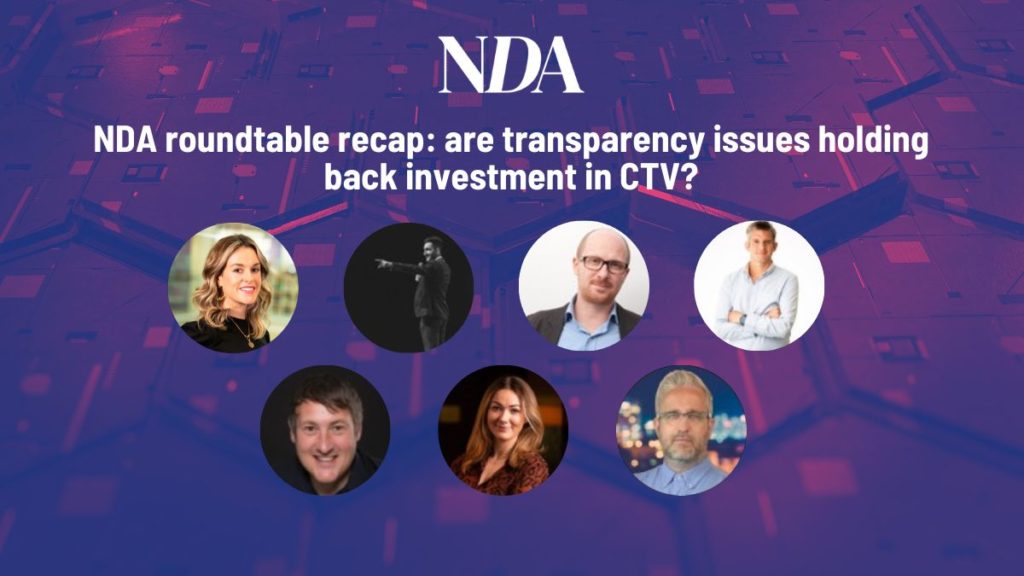The popularity of Connected TV continues to grow, with more than two-thirds (67%) of UK households now in possession of an internet-enabled television. For advertisers, CTV offers incredible potential to deliver precision-targeted, creatively-optimised advertising in a premium environment, however, the fragmented buying landscape and variable levels of transparency around CTV ads risk hampering further investment.
New Digital Age recently invited a panel of senior industry experts to discuss the issue of transparency in CTV in more detail. NDA editor Justin Pearse chaired the discussion, where he was joined by: Rob Blake, Country Manager UK, Channel Factory; Alexis Wrightson, Lead Product Specialist, Quantcast; Amy Tocock, Director of Investment Strategy at PHD UK; Charlie Glyn, Ad Technology Leader, Channel 4 Sales; Andy Jones, Head of UK Sales, Samsung Ads; Gavin Stirrat, CEO, Adimo; and Rhys McLachlan, Director of Advanced Advertising at ITV.
Amy Tocock , Director of Investment Strategy at PHD UK, opened the conversation with the assertion that clients are chasing eyeballs on CTV that they’re losing from linear TV. She said: “They understand that they need to move from one to the other to maximise their reach, but they’re coming from a position where they can scour the performance of every linear TV spot, both their own and their competitors’, to an unbelievable degree. There’s an expectation that CTV ads will be able to deliver the same sort of granularity of feedback and, right now, that isn’t always the case.
“At the moment, the world of CTV is fragmented and so unbelievably complex. There’s so many stakeholders involved in the process it can take a long time to get even simple things done. Even within a single agency, the traditional silos between AV and Digital buying teams can slow things down, although things are improving on that front. Having a standardised view across the performance of CTV campaigns is the Nirvana that we’re all striving towards but we’re not there yet.”
“At PHD we are solely focussed on working with CTV partners with professionally produced, long-form content, 100% viewable, 100% completion…i.e. linear TV sets the bar to which we compare all media partners for AV awareness activity. After a year of testing we are confident that audiences are actively engaging with the content and there is reasonable scale to be found, and this has proven to add value to our activity by independent reach and frequency measurement.”
Gavin Stirrat, CEO of Adimo, added: “If you think about the various waves of digital advertising to date, we’ve had display, we’ve had mobile, and now that we’ve reached CTV, a lot of lessons have been learned by advertisers. That’s why the bar on transparency seems to be a bit higher for CTV. The whole space tends to get muddied by the lowest common denominator. The fact that there’s a million tech companies who might be doing the buying also makes it harder to keep track of exactly what’s going on.”
Degrees of transparency
Charlie Glyn, Ad Technology Leader at Channel 4 Sales, pointed out that the term ‘transparency’ can be considered from two angles, fraud and context, and that comparatively speaking, the level of fraud being seen in Broadcast CTV advertising is actually very low.
“Brands’ main concerns with CTV are around transparency in the sense of not always knowing exactly where their ads are appearing, which is something they are used to knowing with linear TV inventory,” said Glyn.
“From the perspective of a major broadcaster, it’s less of a challenge for us to alleviate those concerns, as we have make the programming data and our own reporting portal available to advertisers who buy from us directly, but for CTV buys made via DSPs, for example, the question is often how much data can legally be passed back to advertisers – and how much was actually in the bid request?”
Andy Jones, Head of UK Sales at Samsung Ads agreed that direct or indirect buying can lead to different data being available to advertisers: “If you’re buying indirectly, you still need consistency and transparent measurement, but having the correct consent and permissions in place can be a real challenge for DSPs, for individual apps and platforms and for Original Equipment Manufacturers like Samsung.
“So, it’s not always a question of a particular party in the supply chain actively wanting to be ‘non-transparent’. If you share viewer data with the correct consent in place, you could find yourself in a lot of trouble very quickly from a legal perspective. As a result we’ve spent the last couple of years developing and launching our own consent management platform (CMP).”
Jones believes the caution being displayed by Broadcasters and OEMs around CTV advertising is a positive development for the global marketing industry. He said: “We’re not stumbling into the same errors that we’ve seen in the wider digital world. Broadcasters have moved into CTV slowly but in a really good, considered way. They’ve shifted into this programmatic world on their terms and I think the whole market will benefit from that.”
The quality mentality
Alexis Wrightson, Lead Product Specialist in EMEA at Quantcast, commented: “With linear TV buys, media planning has traditionally been done with content and ‘moments in time’ in mind. The new disruption around CTV means that a lot more digital planners from a programmatic background are moving into CTV and the traditional digital mentality doesn’t always fit. Content is still really important here, with emerging online channels like Fail Army capturing big audiences via CTV.
“The broadcasters, the platforms like YouTube, and OEMs are all bringing different parts of the future of CTV advertising to the table, so that a lot of the issues facing advertisers today will soon be resolved. In the short term, advertisers should focus on approaching CTV from a quality, not quantity perspective and build closer relationships with the broadcasters and platforms that interest their customers”
Rhys McLachlan, Director of Advanced Advertising at ITV, argued that where advertisers are experiencing transparency issues with CTV, the problem is often one of their own making.
He said: “To be candid, as a broadcaster, I don’t really understand the ‘transparency’ issue for brands. We offer end-to-end transparency across the entirety of our estate, providing data on content, position (pre-roll, mid-roll, etc), the device, the app, the situation, the location and so on. Advertisers should always know where their ads are running, irrespective of channel, irrespective of media type.
“I think there’s sufficient supply in ‘tier one’ CTV to meets the demand in the market right now, so if you’re buying ‘tier two’ or ‘sub tier two’ inventory on CTV, and not seeing the transparency you want, frankly, that’s a problem you should have seen coming. CTV is like the Klondyke right now with lots of new players rushing in as there’s money to be made, so it’s important to work with the right partners.”
However, Rob Blake, UK Country Manager for Channel Factory, argued against feeding too narrow a range of content channels: “Some of those ‘tier two’ providers are actually very good content producers, often serving niche and diverse audiences that could work really for specific brands. Unfortunately, with the current economic pressures on brand CMOs and their agencies, there’s always going to be a tendency to play safe. I think there’s more of a lack of knowledge around how to plan effective CTV campaigns than there is a lack of transparency, but I expect to see a lot of innovation and education in this space over the next couple of years.”









